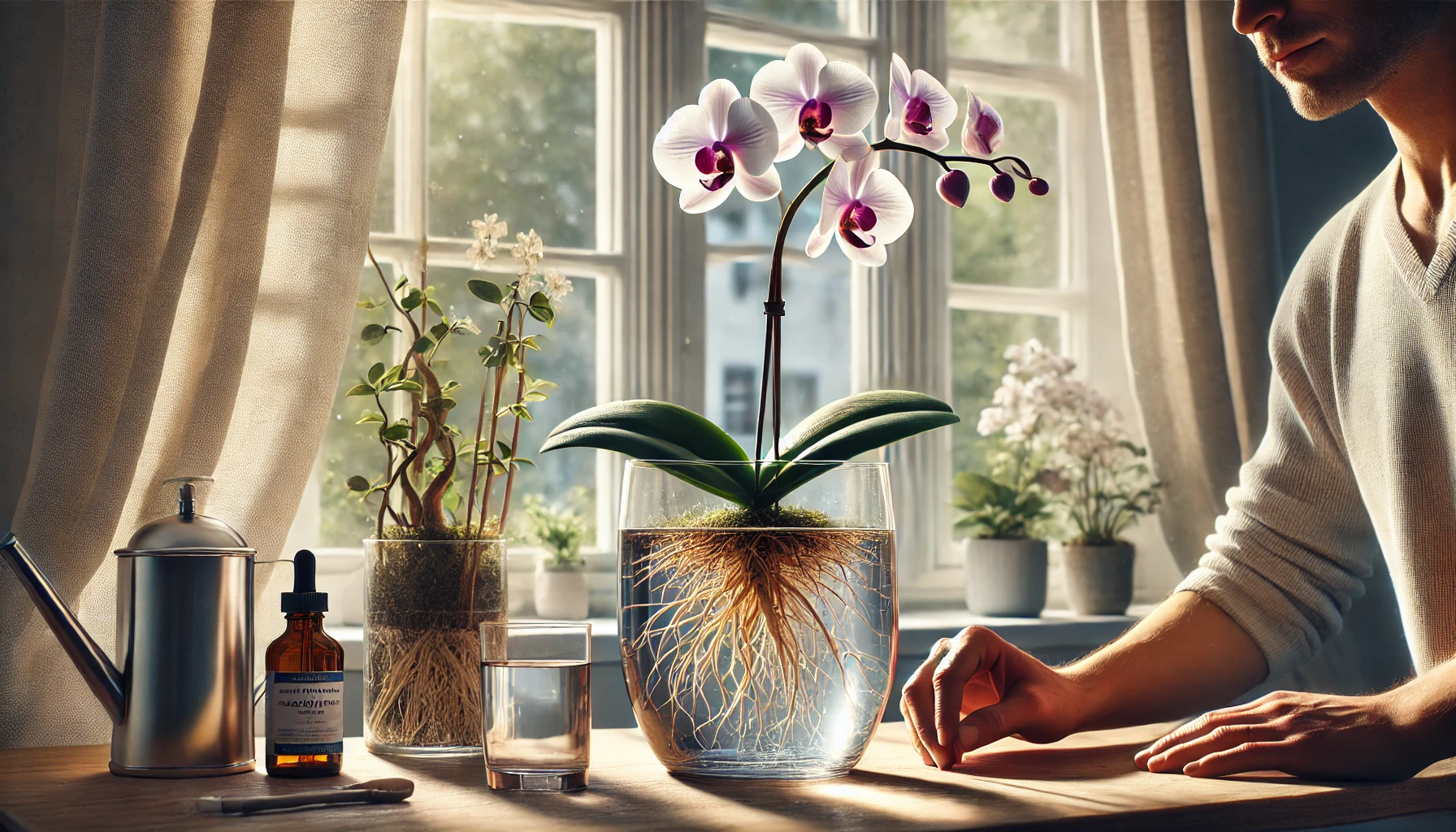Orchids are typically grown in bark or sphagnum moss, but some growers experiment with growing them in water, a method known as hydroponic orchid care or semi-water culture. This technique can be an alternative for those struggling with root rot or wanting a low-maintenance approach. But does it really work? Understanding the benefits, risks, and proper techniques will help you decide if growing orchids in water is right for you.
🌱 Can Orchids Grow in Water?
Yes, some orchids can grow in water, but they need special care. Unlike typical water plants, orchids do not naturally grow with their roots submerged. Instead, they thrive in humid environments where their roots are exposed to air and moisture.
✔ Orchid Species That Adapt Well to Water Culture:
- Phalaenopsis (Moth Orchid): The best candidate for water culture due to its adaptable roots.
- Vanda Orchid: Naturally grows with exposed roots and can tolerate soaking.
- Dendrobium Orchid: Can adjust to semi-water culture but prefers some drying periods.
💡 Not all orchids can transition to water culture. Some species, like Paphiopedilum and Cattleya, prefer traditional potting media.
💧 What is Water Culture for Orchids?
There are two main methods of growing orchids in water:
✔ Full Water Culture (FWC):
- The orchid’s roots are submerged completely in water at all times.
- Works best for orchids that have already adjusted to water culture.
- Requires frequent water changes to prevent bacterial growth.
✔ Semi-Water Culture (SWC):
- The orchid’s roots are soaked in water for part of the week and left dry for the rest.
- The most common and safest method for transitioning orchids to water culture.
- Reduces the risk of root rot while still providing hydration.
💡 Semi-water culture is the preferred method because it mimics natural conditions where orchids experience moisture and drying periods.
🏺 How to Transition an Orchid to Water Culture
If you want to grow your orchid in water, transitioning gradually is important to prevent root shock.
✔ Step-by-Step Guide to Water Culture:
1️⃣ Remove the orchid from its current pot and rinse off all bark, moss, or debris from the roots.
2️⃣ Trim any dead or rotting roots with sterilized scissors.
3️⃣ Place the orchid in a glass vase or jar with fresh, room-temperature water.
4️⃣ Start with semi-water culture, soaking roots for 2–3 days, then letting them dry for 4–5 days.
5️⃣ Observe the roots—if they stay healthy, you can adjust the water schedule as needed.
💡 If roots turn brown or mushy, reduce water exposure and allow more drying time.
🌿 Best Water Type for Orchid Water Culture
The type of water you use matters in hydroponic orchid care. Tap water often contains chemicals like chlorine and fluoride, which can harm orchids over time.
✔ Best Water Options for Orchids:
- Rainwater: The most natural and nutrient-rich option.
- Distilled Water: Pure and free from harmful minerals.
- Filtered Water: Removes chlorine and impurities while keeping some beneficial minerals.
💡 Change the water every 3–5 days to prevent bacterial growth and provide fresh oxygen.
🚫 Common Problems When Growing Orchids in Water
While water culture can work, some risks come with keeping orchids submerged.
❌ Root Rot: If roots stay wet for too long, they may become mushy and start rotting.
❌ Algae Growth: Standing water in glass containers can lead to green algae buildup.
❌ Lack of Oxygen: Orchids still need oxygen, and stagnant water can suffocate roots.
✔ How to Prevent These Issues:
- Always use clean water and change it regularly.
- Keep the orchid in a well-ventilated area with indirect sunlight.
- If algae appear, wash the container and replace the water more often.
💡 Healthy orchid roots in water culture should be firm and green when wet, and silvery-white when dry.
🌸 Can an Orchid Bloom in Water Culture?
Yes, orchids in water culture can bloom, but they may take longer to adjust.
✔ How to Encourage Blooms in Water Culture:
- Keep the orchid in bright, indirect light for at least 10–12 hours daily.
- Use a bloom booster fertilizer (10-30-20) every 2 weeks to encourage flower spikes.
- Maintain a cool nighttime temperature (55–65°F / 13–18°C) to trigger flowering.
💡 Orchids may take several months to bloom after transitioning to water culture, so patience is key!
🏡 Best Containers for Growing Orchids in Water
Choosing the right container is important to provide good air circulation and prevent bacterial buildup.
✔ Best Containers for Water Culture:
- Glass vases or jars: Allow root monitoring but should be cleaned often.
- Slotted glass containers: Provide some airflow to reduce stagnation.
- Tall narrow vases: Help keep the orchid stable without submerging the base of the leaves.
💡 Avoid completely sealing the top of the container—orchid roots still need airflow!
🚑 How to Switch Back to Potting Mix If Water Culture Doesn’t Work
If your orchid doesn’t adapt well to water culture, you can safely transition it back to a potting mix.
✔ Steps to Move an Orchid from Water Back to a Pot:
1️⃣ Remove the orchid from water and let the roots dry for a few hours.
2️⃣ Trim any damaged or unhealthy roots.
3️⃣ Repot the orchid in a well-draining mix of bark and sphagnum moss.
4️⃣ Water lightly for the first week to help the orchid adjust.
💡 Some orchids may prefer water culture for a short period but grow better in traditional media long-term.
🛡 Final Tips for Successfully Growing Orchids in Water
✔ Start with semi-water culture before trying full water culture.
✔ Use clean, filtered, or rainwater and change it every 3–5 days.
✔ Monitor roots closely—adjust watering schedules based on their health.
✔ Keep orchids in bright, indirect light to encourage growth.
✔ If root rot develops, allow more drying time between water changes.
By following these guidelines, you can successfully grow orchids in water and enjoy a unique, low-maintenance growing method! 🌸✨
